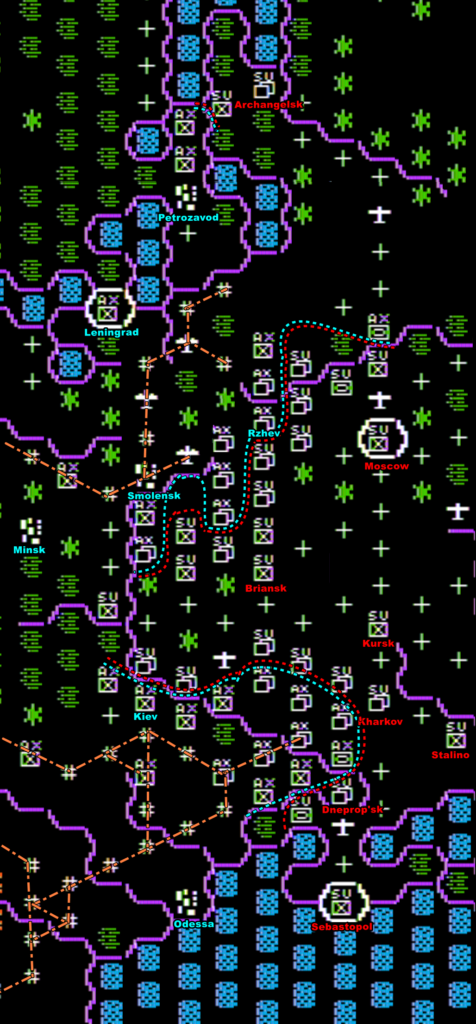
We are back to War in Russia, for the second year of a war that should have ended triumphantly a few months ago. I guess we will just all be home next Christmas.
I start with an excellent position in the North: I control Murmansk and Leningrad, I have isolated Archangelsk and I am two weeks away from Moscow, or rather I would if there was not a horde of enraged but well-entrenched Soviets on the way. Not counting the defenders of Archangelsk, there are only 2 Soviet units North of the Volga, so once the weather clears I can move East and then fall South at leisure. In the South, I underperformed against history, but at least my defensive position is solid and well-supplied.
The target for 1942 is of course Moscow. From Rzhev, there is only one layer of units fortified in open terrain to go through before reaching Moscow, so I expect 1942 to be a brutal assault as soon as the weather clears, with my Panzers eventually prevailing against whatever the Soviets field. This simple plan never had a beginning of execution, because the weather did not cooperate – where General Winter had failed, General Mud triumphed, for a time, and the war went in a totally different direction.
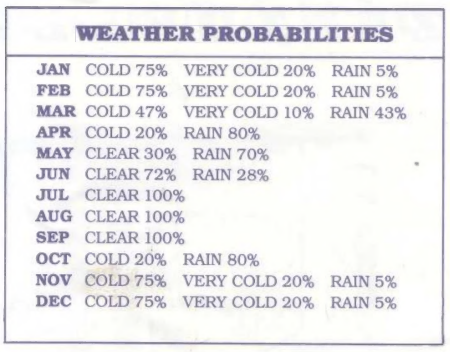
Spring 1942
I expected spring to bring a mix of rain and cold, but ultimately it would be almost all rain, with one cold week and one very cold week. As I keep waiting for the rain to stop before going all-in, I try to adjust the frontline in my favour. I am marginally successful in the centre, where I manage to push back the Soviets that approached Smolensk, chase the one unit North of the Volga and slightly readjust the front around Rzhev. While the latter change allows me to build a railroad to that city, am not sure the outcome was worth the losses and the combat experience given to the Soviets. In the South, it’s worse: I launch assault after assault on Kharkov, but all I manage to do is to train its defenders.
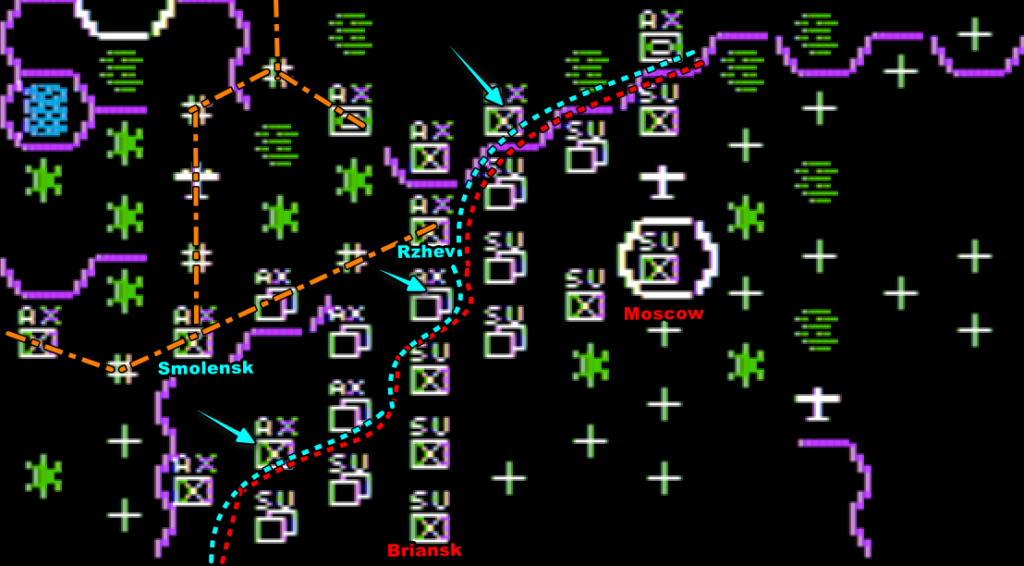
That’s frustrating, because the Soviets are reinforcing every turn around Moscow. The single layer of defensive units has become a double layer of defensive units. Starting in April the Soviets also start to receive Lend-Lease in Archangelsk, in addition to the units they keep building.

And there is nothing I can do for now as Archangelsk is well-protected and supplied every turn… by Archangelsk itself. A supply depot spawns there every turn and is immediately forced to distribute due to the angry Finns hiding in the snow:
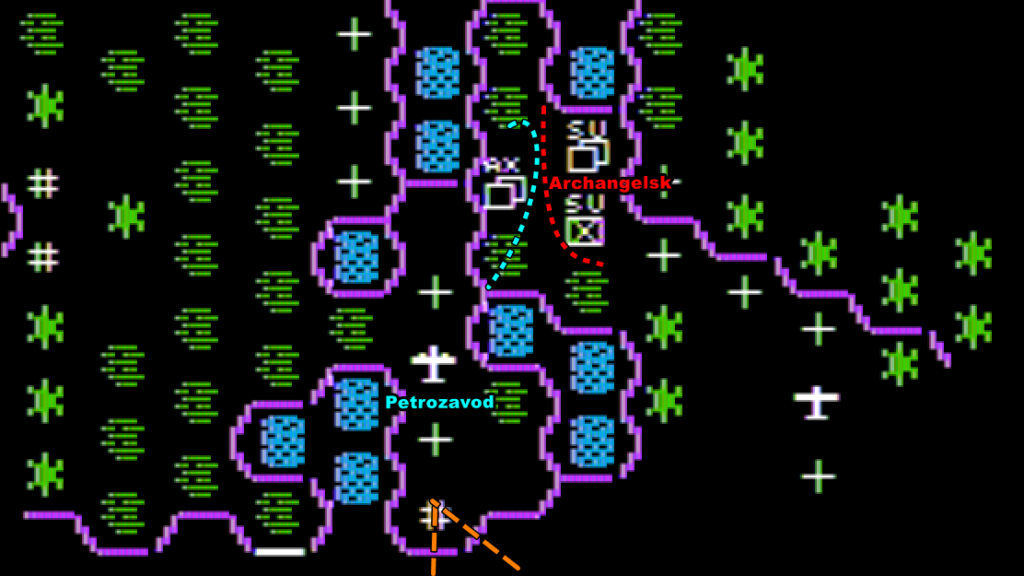
On my side, I am at least blessed with the arrival of Hungarian troops early April. They’re not outstanding but eh, they’re free!
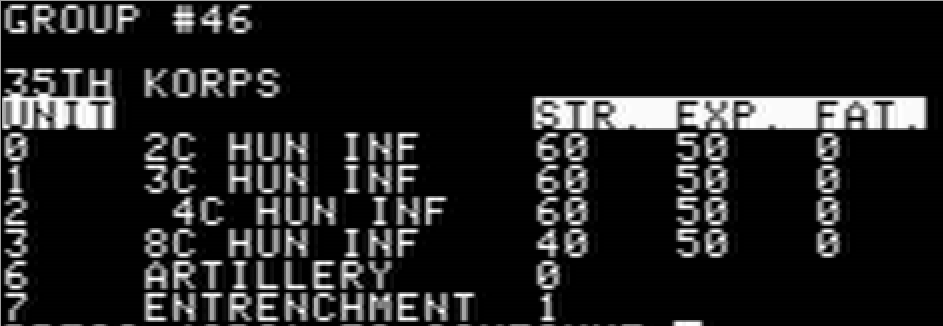
More significantly, two decisions in April would prove momentous for the rest of the game:
- After focusing exclusively on “heavy factories” thus far in the campaign, I start focusing my industrial development on vehicle factories. As the front is relatively calm I don’t use my “vehicle reserves”, which slowly grow to more than 1000 by mid-April – a threshold which increases the effectiveness of supplies on reducing fatigue,
- I had deployed all my artillery in front of Leningrad and Kiev. After the fall of those cities, all the artillery I had deployed returned to the reserve, and was available for distribution to the Romanians (soon joined by the Hungarians) deployed in front of Dneprop’sk, an isolated holdout locking the way to Sebastopol… and also preventing my supplies from reaching anything East of Kharkov.
In mid-April, I have as many guns as I need and the two central European nations start their assault on Dneprop’sk, first with guns alone, then with men. Dneprop’sk, as fortified as it is, cannot be supplied, so any damage to the garrison is final – it is just a question of time. The rest of the front does not move much, though I manage to insert some units between Moscow and Briansk.

In May, the Soviet front starts to dislocate. Near Moscow, I double-down in the gap I created between Moscow and Briansk and effectively cut the Soviet lines in two. In the South, Dneprop’sk finally falls to the Romano-Hungarians. I immediately transfer some of my Panzers currently idle in the North to the Southern front, and push a force between Kharkov and Stalino.
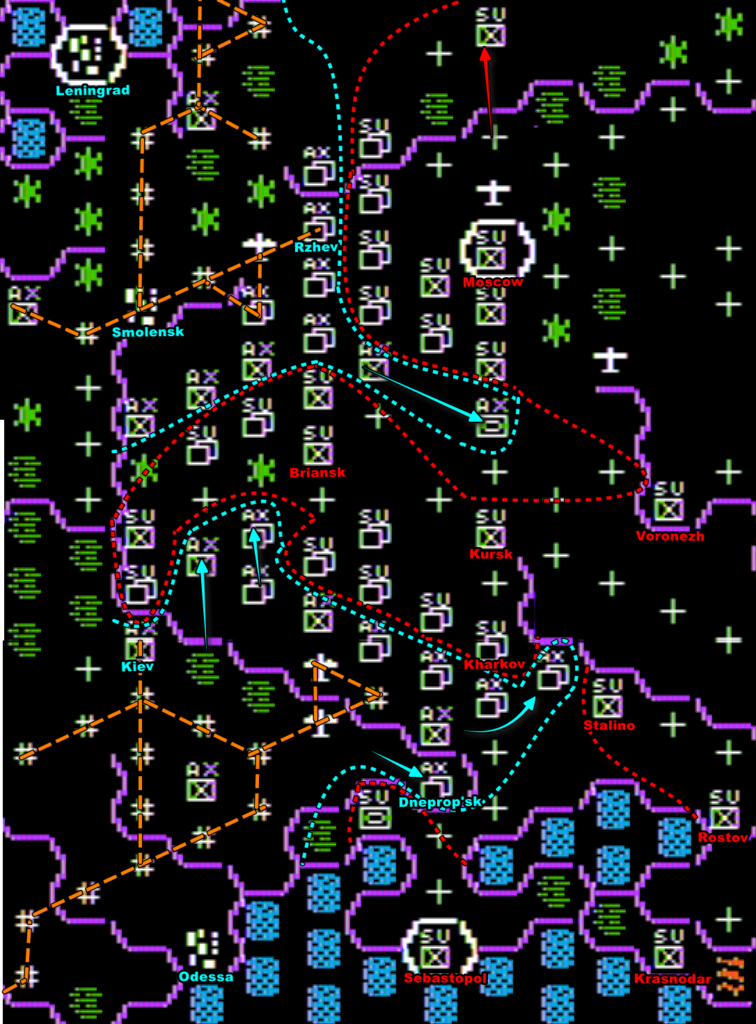
Mid-May, the garrison of Kharkov, as sturdy as it is, is now facing 6 of the best German divisions, 4 of which being supported by a generous complement of artillery. If Kharkov falls, I am confident I can also storm Kursk. It will enclose a good third of the Soviet forces in the Briansk pocket and maybe, if it all unfolds fast enough, encircle Moscow by the East.
June 1942 – The battle of Kharkov
June is mostly about the brutal battle for the conquest of Kharkov. Against all odds, the weather continues to be muddy for 3 more weeks in June, but I feel like I can’t wait any more and launch my all-out assault against the city. It is a good opportunity to explain battle resolution.
From “probing” attacks in March and April, I know what’s inside Kharkov: 8 Rifle Divisions (max strength: 90) and one Cavalry division (max strength : 60), so 780 strength points max. As for me, I am bringing 6 full-sized corps, (so 6 divisions each) mostly mechanized but also some infantry. On average, let’s assume 110 strength points by division (Infantry: 70, Motorized 100, SS Motorized 140, Panzer 150), so close to 4000 strength in total.
In addition to strength, there are other factors to take into account:
- Fatigue: I assume the Soviets to be fully rested (they are in supply), and while 4 of my corps are also fully rested, the 2 corps between Kharkov and Stalino have not recovered fully from two movements in a row in the mud – they are at around 30% fatigue. It averages out at 10% for all my divisions, so now my “effective” strength is around 3600.
- Experience: The Soviets have not upgraded to “Guard Division”, so their experience level is between 50 (the “default” and 80, let’s assume 70 to be sure. 780 x 1.7 = 1300. On my side, all my units are veterans with 90 experience or more, so now my strength is 3200×1,9 = 6800.
- Weather: Attacks in muddy terrain are halved, so back to 3400!
- Finally, the Soviets are presumably fully fortified (level 5 fortification: strength x2) so their final strength is going to be 2600
The expected ratio is 3400:2600, so 1.3, but my artillery will prepare the assault by removing roughly 1% enemy strength and adding 1% fatigue for every 30 points of bombardment – that’s how I understand the hermetic manual anyway. With a bombardment value of 226, plus some planes, that’s around 8% of each, so after bombardment the odds should be more or less 3400:2250 (1.5).
My objective is of course to dislodge the Russians, which requires removing all their fortification and fighting them at 4:1 ratio. I need at least a 2:1 ratio to start chewing through the fortifications, but I had misunderstood some of the rules and I had expected to fight them at a 3:1 ratio…
… and it turns out that I am correct after all:

This is how I find out that my units between Stalino and Kharkov are blocking the supplies Kharkov should receive from the East, and those transiting through Kursk are actually going further West, toward Briansk. This prevented Kharkov from replacing its strength and fatigue losses sustained late May as I constantly bombarded with artillery and from the air. A second attack further increases my ratio, and I break through on my third attack:

The 2nd Panzer Corps, now occupying Kharkov, is in a sorry state, but it won:

Auspiciously, the rain and the mud finally vanish in the last week of June, allowing me to approach Kursk, the last lock of the Soviet Union, from all sides:
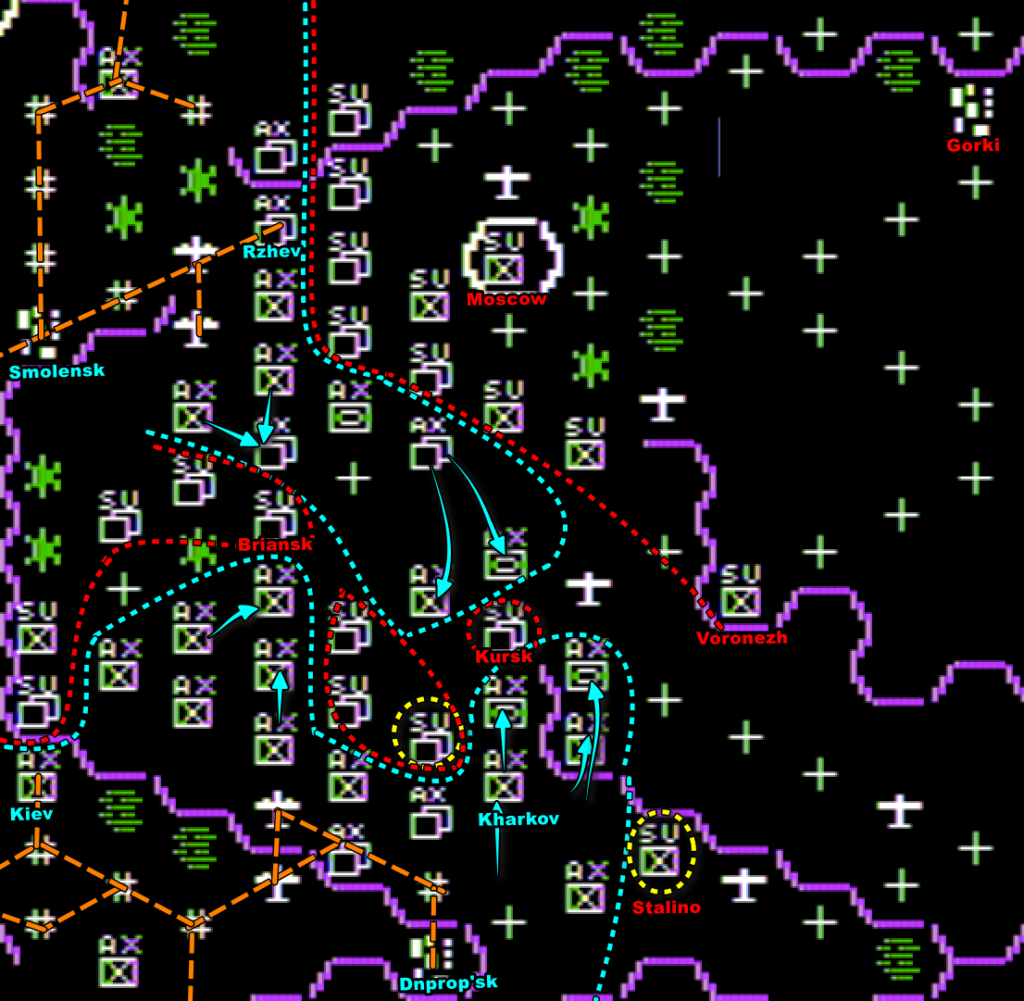
The attack on Kursk has to be postponed though: as long as the two units circled in yellow hold their position, I can’t send supplies to the units attacking Kursk. The one in Stalino is supplied and well-fortified. I should be able to remove the Western one – but I need to do it quickly, before the Soviets plug the gap between Moscow and Voronezh.
Summer 1942 and the Battle of Kursk
I have an opportunity to win the war decisively, and I must seize it. I transfer all my planes to the two air groups between Kiev and Kharkov – no other location on the map is as strategic at the moment, except maybe the Archangelsk front which receives a newly created Panzer Corps:

In clear weather, I have all the advantages: my planes never miss their targets and attack at 100% efficiency, my Panzer divisions have +50% attack strength and I can restore 50 fatigue by turn to units within supply range. It takes me only two weeks to remove the Soviets preventing me from connecting Kharkov to the rest of my supply network:

Kursk is next, and my Panzer divisions are well-rested against green troops. In two weeks, it is done.
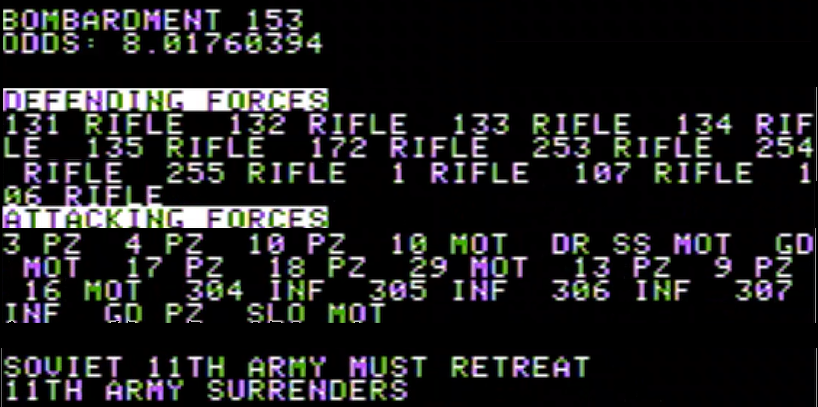
This is the end of the Soviet Union. Kursk fell with the summer still young, and I have 2 months to exploit in depth. Good news pile-up: by the end of July I am well on my way to cut Moscow from the rest of the Soviet Union. In the North, the Finns capture Archangelsk, and in the South the Romanians put Sebastopol under siege.

Two months later, as summer comes to a close, there is no more frontline. My tanks have assaulted Voronezh, seized Gorki by surprise and are now at the gates of Saratov. Moscow is isolated, though its reduction will take several more months. I will win if I take Moscow, Gorki and Kuybyshev, so I don’t see what could save the Soviet Union.
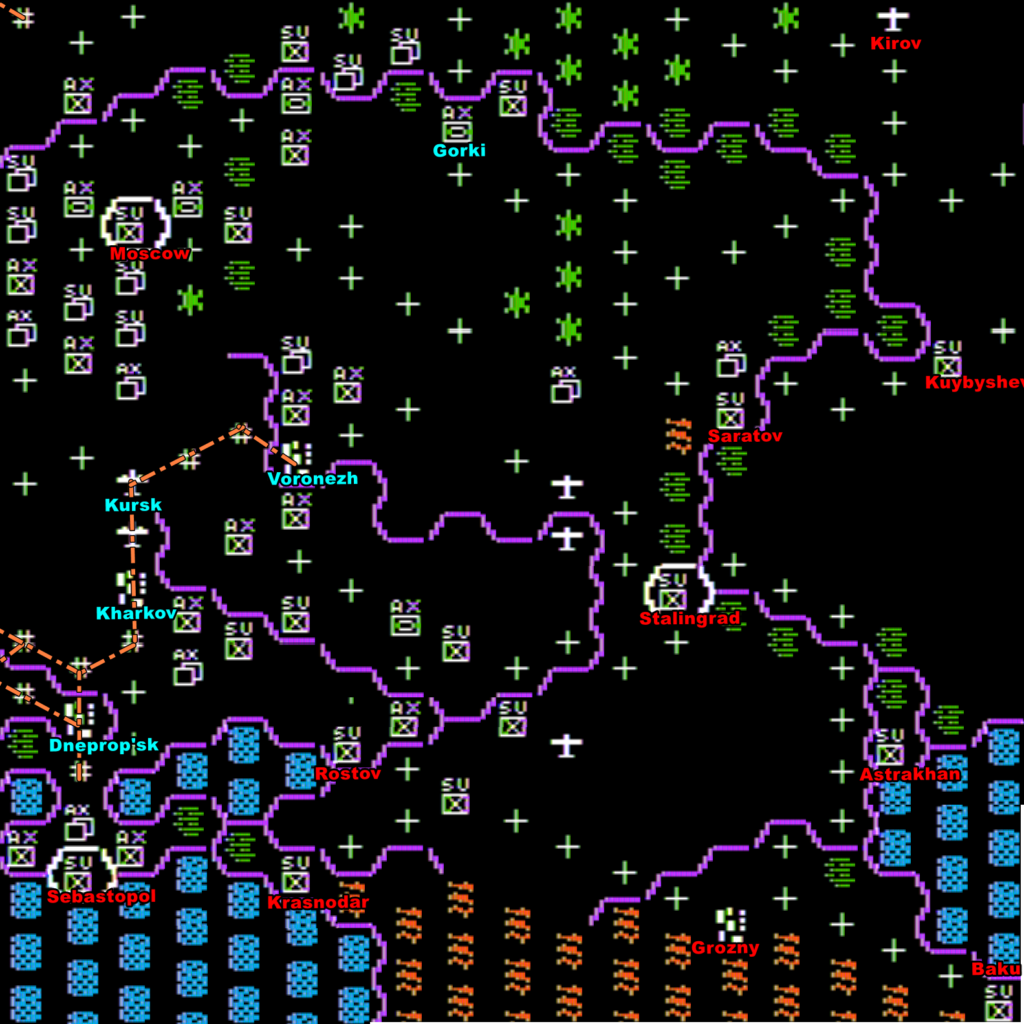
Rasputiza 1943
October pauses most of my Panzers. Not much happens because it is all mud-mud-mud. I still manage to snatch Saratov, Stalino and Sebastopol as they were adjacent to my forces, but nothing more. The slow grind near Moscow carries on.

As for the Soviets, they fortify their Southern front (near Rostov) before massing up near Gorki – but they never attack.
Winter 1942-1943
This is the endgame. My main constraint is the supply range: my depot can move 4 times in non-railroad terrain, and then supply at a range of 2, so their total supply range is 6. Mechanized units which have been supplied can move by 4 hexagons, and after that by only one by turn – my maximum range is 10 for tactical shenanigans.
November comes & goes, and I start to work on the Voronezh-Saratov line. In the middle of December, I finally take Moscow… just as the Soviets expel me from Gorki – it was too far to be resupplied.

In the middle of January ’43, the railroad almost reaches Saratov. I had managed to sneak a unit earlier on to take Grozny, and do the same with Kirov, cutting the supplies of the Soviets near Gorki:

Once the railroad reaches Saratov, I immediately bring two more Panzer Corps and as many supplies as they require to take Kuybyshev. It takes me two more weeks, and Kuybyshev is mine. One week later, I snatch Gorki again, which had been inexplicably left undefended, ending the war in a decisive victory and with two years to spare.
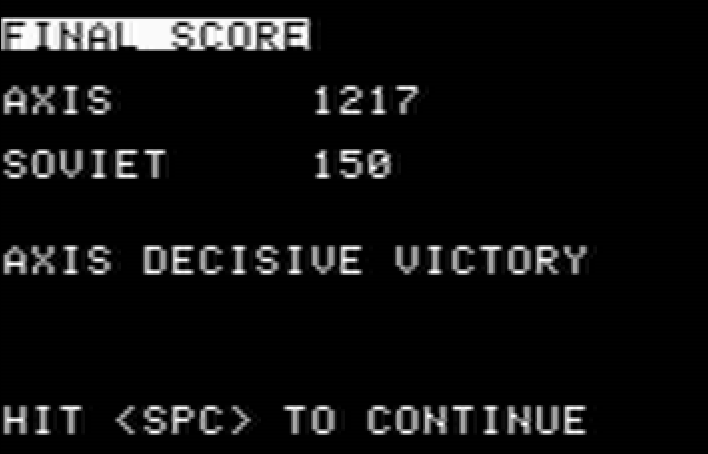
This has been a long campaign: 20 months, with each month taking between 30 minutes and one hour to play (read the final review here). It was, however, surprisingly pleasant to play – so much so that I am tempted to test the 1942 campaign for myself – no more AAR on this game, I promise. I won’t be trying the third “Kursk” scenario though, because Gary Grigsby’s next game is called Objective Kursk and uses the same engine, and the less I wargame Kursk, the better I feel.
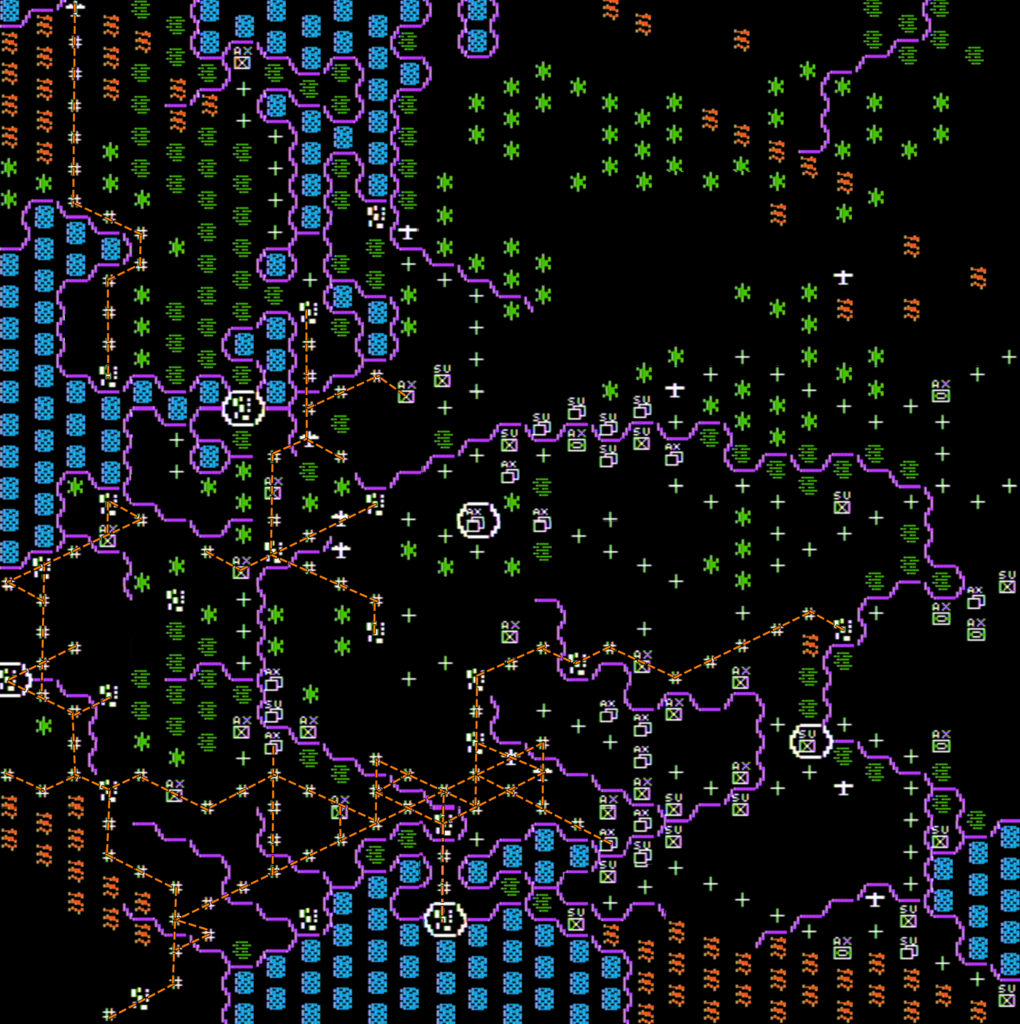
But before Objective Kursk, I am looking for some (passive) crewmates for my personal B-17 bomber in 50 Missions Crush. It will fly mostly safe missions over France, Netherlands and (who-knows?) Germany. I can promise you that this time, no one will be leaping to their death without a parachute! Let me know in the comments!

15 Comments
Another fantastic review of what looks like a fantastic game. Tactics! Strategy! Logistics! Slovakians! It’s got the lot!
And Snorkers is reporting for duty as Tail-end Charlie!
At least from a perspective of someone just reading about it, this one really sounds like the culmination of this simple and somewhat ugly early style.
Anyway, feel free to put me in as a gunner.
50 Mission Crush was on my initial SSI shortlist but one I decided not to cover. I volunteer to inventory and safeguard the parachutes. No reason.
> Experience: […] now my strength is […] 6800.
> Weather: Attacks in muddy terrain are halved, so back to 3900!
Either “halved” is just an approximation or something in the calculation does not match.
Anyway, great AAR as always, I would have wished for a third part! Looking forward to the R&R – from your description the game feels really important, deep and carefully made, but will that be enough to justify the immense amount of time it requires?
No, it is a mistake. That should have been 3400, good catch.
Updated. The ratio I had were correct (1.3/1.5) so I calculated correctly and then made a mistake while transcribing.
Oh, and as long you are doing the work, feel free to embark me for the B17 missions! I’m not sure how I, a renowned XVII-century fortress architect, may best serve, but maybe the position as engineer could be the fittest. Anyway, I’m open for the other roles in case that job is already taken.
Put me in as a bombardier. Can’t wait to enjoy the fruits of the Allied technological superiority in bombsights!
I’m happy to deal with the bombing sights on a B-17, as Tom Cat. Also, I’m happy that I was able to live the experience of this game through you – I lack the time and, frankly, patience to see something like War in the East through, even though I love the idea very much. And those older games, lacking modern UI niceties, seem to be even more demanding in the patience department…
Terrific AAR for the Grigsby monster! I have long wanted to see how it played but it always scared me off.
Sign me up for the B-17 flight… where’s the safest space on the old bucket.. radio operator?
We do love maps with lots of arrows!
I’ve got my cool leather bomber jacket on, show me to the co-pilot or navigator seat (is it a bad sign I have to be shown where to be a navigator?).
Put me in the game, coach
Up for dying gloriously
So the Wehrmacht can prevail when there’s no political meddling from Berlin (I guess Grigsby couldn’t fit that aspect into the game). Nice job!
In earlier Grigsby games UI and AI seemed to be weak links. From this AAR I get the sense that UI was better here and Grigsby was improving as a designer. In the R&R I would interested to read how you feel about the AI opponent. Was it improving and how it compares to that of Eastern Front?
It would also be interesting if you can dig up any tidbits about was it difficult to fit this monster into a 8-bit machine and balance it. For example, was there any other limits than that 199-division limit?
I could also participate in safe flying over European skies as a port side gunner. I hope his position in the plane is close enough to the escape hatch.
Well folks, we are ready to go! Ahab is ground crew since he wanted to take care of the ‘chutes, but once a seat, well, “becomes available”, he will join us! Same with any future volunteers, until we do our 50 missions or Scribe bites the 20mm round.
Here is the crew of the “Impatient Virgin” before their first mission above Abbeville.
Put me down in reserve. I’ve seen enough Masters Of The Air to know that’s PERFECTLY SAFE
It makes sense. Those big planes fly 30 000 feet or more. What are the Germans gonna do – shoot at them from the ground?